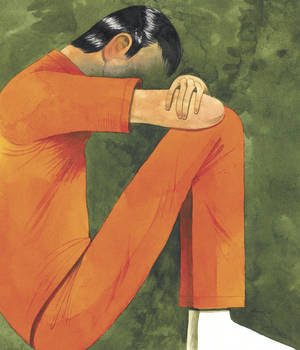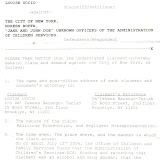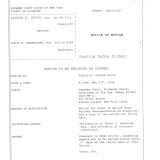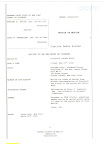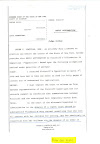REFRESH - Go to Home-PageJustice Denied:
How Family Courts in NYC Endanger
Battered Women and Children
Executive Summary
“Each time that I appeared in court, the system reinforced his dominance over me by preserving his parental “rights” without regard to my safety. I felt totally undermined by the court.” P.W.
Each year thousands of women are abused in New York City by an intimate partner. In 2007, the NYPD responded to 229,354 domestic violence incidents and the domestic violence hotline responded to 123,409 calls. To address alarming reports by survivors of domestic violence about family court decisions that endangered them and their children and that failed to hold their abusers accountable, the Voices of Women Organizing Project (VOW) launched the Battered Mothers’ Justice Campaign.
VOW is a grassroots advocacy organization of survivors of domestic violence who are working to improve the many systems battered women and their children rely on for safety and justice. VOW members represent the diversity of NYC and include African American, Caribbean, Latina, white, Asian, immigrant, lesbian and disabled women. Since 2000, VOW members have documented system failures and developed recommendations for change, and they have educated policy makers, elected officials, the public and each other through trainings, meetings, testimony and, most recently, with this report.
Domestic violence takes many forms: emotional/psychological, financial, sexual or physical. Batterers isolate their victims and control their activities; humiliate them and damage their self-esteem; and undermine their relationships with their children. The abuse can escalate to severe physical and/or sexual abuse.
When abused women attempt to separate from their tormentor, they are often threatened with the loss of their children. Many abusive men are able to make good on this threat by making false and malicious child abuse reports against their partners or by fighting for custody and winning. Nationally, abusive fathers are estimated to be more likely to seek sole custody than non-violent fathers and are successful about 70% of the time. Another tactic used by batterers is to bankrupt their partner through excessive litigation or denial of child support. Victims of domestic violence can suffer from depression or PTSD (Post Traumatic Stress Disorder) and therefore present poorly in court and to custody evaluators or law guardians.
Women are re-victimized by the Family Courts when allegations of domestic violence and child abuse are minimized or ignored and when the abuser is either not held accountable or judged to be more credible. Studies show that 25-50% of disputed custody cases involve domestic violence, and there is a significant overlap between domestic violence and child abuse. Yet, family court judges, lawyers and law guardians (court-appointed lawyers for the child) operate on the pervasive myth that mothers lie about domestic violence and child abuse, especially child sexual abuse. In fact, fathers are far more likely than mothers to make intentionally false accusations (21% compared to 1.3%). And, while child sexual abuse allegations are infrequent (approximately 6%), two-thirds of the allegations are substantiated.
The courts are overburdened. In 2006, only 47 judges handled more than 210,000 filings and depositions in family courts in New York City. The majority of the cases involved support (55%), custody/visitation (26.5%), family offenses, i.e., domestic violence (7.5%) and child protective proceedings (6.5%). Kings County Family Court, the busiest family court in New York State, handles approximately 16,000 custody and visitation cases and 4,000 child protective cases annually.
Battered Mothers’ Justice Campaign
VOW launched our Battered Mothers’ Justice Campaign in 2003. Working closely with the Urban Justice Center’s Human Rights Project, VOW developed a comprehensive human rights documentation project to collect quantitative and qualitative data on the experiences of battered women in New York City family courts. From May to December of 2006, VOW trained its members to become human rights documenters who captured the experiences of over 75 domestic violence survivors of New York City family courts. Two focus groups were conducted with members of VOW, who were battered women, and with teens removed to foster care. Meetings were conducted with researchers at several local universities and with experts in the field. Safety evaluations of each borough’s family court were conducted between August 2007 and January 2008. VOW members met with court personnel, including Chief Administrative Judge Joseph Lauria, testified before the Matrimonial Commission hearings, and reviewed hearing findings.
The survey interviews, focus groups and court safety assessments reveal a family court system that is badly in need of oversight and repair. Much of what we found should come as no surprise to court administrators: testimony at the Matrimonial Commission hearings revealed many of these problems. In addition, several books, reports and Speak-Outs dating from 1981 to the present have documented custody decisions and other cases of gender and racial bias, corruption and incompetence that endanger children.
This report is also one of many recent studies that have documented the human rights violations of family courts across the country. In 2003, the Battered Mothers Testimony Project in Massachusetts and a subsequent report on the Arizona family court system revealed that those states too were endangering battered mothers and children. The similarities between the findings point to a system that is laced with gender bias and flawed cultural norms and whose principals – the family court judges, lawyers and law guardians – neglect their obligation to protect mothers and children.
The Battered Mothers’ Justice Campaign aims to build a case for a large-scale investigation into the family court’s failure to protect battered mothers and children and to call for more transparency and oversight of the family court system. This report is just one attempt to give credibility and voice to the women who have to navigate a system that is often stacked against them and has the ultimate power over them – the ability to take their children from them.
Summary of Findings
1. A court system that doesn’t follow the law or its own policies and procedures.
Women reported court procedures and rulings that are often in violation of due process.
Ex-parte communication between one party and the judge is a frequent occurrence. 32% of interviewees said their ex-partner’s attorney or the law guardian spoke to the judge without her or her lawyer being present.
Witness testimony is not always allowed. Less than 20% of those interviewed said their witness was allowed to testify. Many others did not know they could bring witnesses.
Transcripts may not accurately reflect what happens in the courtroom. 15% of those surveyed said the transcripts were not accurate. 67% could not afford to buy copies of the transcript so did not know if they were accurate. Several reported that transcripts were missing. 15% said the judge told the stenographer to stop recording or turned off the tape recorder during proceedings.
Law guardians do not always represent their clients’ wishes. Several interviewees said law guardians made a recommendation that resulted in their children being removed from their custody without meeting them or seeing them interact with their children. Law guardians frequently don’t meet with their client more than once if at all. 42% of those interviewed felt the law guardian did not advocate for the safety of their child or take the history of domestic violence seriously.
Although many interviewees were satisfied with their attorney, 42% said their attorney did not understand domestic violence issues.
Unsubstantiated allegations against mothers led to removal of custody. 53% of those surveyed were prevented from seeing forensic evaluations that resulted in their children being removed from their custody. More than a third of mothers surveyed were accused of “alienating” their children, or were given a psychiatric label, often with slim or unsubstantiated evidence for these allegations.
2. Decisions that put children in danger.
“I feel angry and betrayed that after all the intense scrutiny of my life and parenting skills, the microscopic examinations of the law guardian, forensic, lawyers, etc. over two years – the court ordered my abusive ex-partner supervised visitation, to be supervised by my girlfriend. It was over in seconds! Now it’s up to my girlfriend and me with no safety precautions, no guidelines or direction or even past histories to draw upon, to manage visitation with a convicted abuser. No follow up. No reports. No nothing. And if he should pull something, if his anger should rise, how would the two of us protect my daughter, Olivia?” R.P.
Abusers threaten to take custody of children and sometimes win. 80% of women said their abuser threatened to take away their children and used the court to follow through with that threat. 10% of women said they stopped reporting abuse for fear of losing contact with their children.
Mothers were told by their lawyer, the law guardian or the judge not to oppose visitation, even when they felt it was unsafe or when their children protested. Several mothers were threatened by the judge with jail time if they did not force their children to comply with ordered visitation. 56% of the interviewees felt unsupervised visitation would be unsafe for them or their children.
The City’s child welfare agency can perpetuate the abuse. 7% of the mothers said their child was abused while in foster care. Almost half of those interviewed felt the City’s Administration for Children’s Services (ACS) did not protect their children, despite allegations of child abuse. 54% said they were given no help by ACS to reunite with their children.
Adequate child support was often not granted, and the request could mean a custody fight. 58% of the women interviewed stated that asking for child support triggered retaliation by their ex-partner – often a battle for custody. Child support was ordered in only 50% of the cases when it was requested. Even when child support was ordered, less than half of those women and children actually received the support, and the fathers were almost never held accountable. Often the ex-partners hid assets to keep payments low. 65% of the women found the amount ordered to be inadequate.
3. A system that minimizes domestic violence and neither provides protection to victims, nor holds abusers accountable.
There was an overall feeling from most of the women we interviewed that they were not heard and that their experience of abuse was minimized, disregarded or used against them.
Reports of domestic violence were viewed skeptically. While all the women interviewed self-identified as survivors of abuse, only 52% were recognized by the court as such. 25% of the women surveyed were told not to mention domestic violence in the court proceeding. 50% were told by their own attorney, who felt it would hurt their case, and the other 50% were advised to ignore their experience by court personnel, including mediators. Many of the women interviewed complained that they told their lawyers, the judge and the law guardian about prior domestic violence incidents and yet this important information played no role in the case or, worse, was used against them.
Reports of child abuse were viewed skeptically or used against mothers. 57% of women interviewed said that reports of child abuse or child sexual abuse against their ex-partner were not taken seriously in court proceedings. Often these reports triggered accusations of “parental alienation” against the mother trying to protect her child.
Victims of abuse did not feel safe in court settings. 30% of interviewees didn’t feel safe in the courtroom itself, and 40% felt unsafe in waiting areas. Settlement conferences held in cramped rooms were especially intimidating to victims, and long lines to get through metal detectors outside the courthouse posed a real danger. 57% of the women interviewed were unaware of Safe Horizon as an option for a safe place in the court to wait. Of those who used Safe Horizon, most found it helpful.
Confidential information was not safe in court settings. 43% of the interviewees had their confidential address revealed in court via court papers. Many said it was the judge, reading aloud from court papers, who revealed the confidential address of the victim, putting them in danger or forcing them to move.
All the women interviewed described their experiences in courts as extremely stressful and often re-traumatizing to them and their children. The financial toll was sometimes catastrophic, including loss of job due to excessive court appearances and the costs of attorneys, forensics, filings and experts.
4. A system rife with gender bias against women and preferential treatment towards the party who is wealthier or has a higher status.
“As of December, 2007, my children are owed over $190,000 in child support and arrears. My ex-husband has a lucrative comic book business, which we started together during our 14-year marriage. Yet, for the last six years my children and I have been surviving on $800 a month, which is what he has chosen to pay. Many times he has stated to me that he would rather close down the business and go on welfare than to pay me child support. The courts have not done anything about it and refuse to see the connection between domestic violence and a defiance to pay child support. This is what domestic violence looks like – and we are a family still suffering its effects six years later.” E.A.
Examples of ex-parte communication and bias in favor of fathers were cited, including fathers not being held accountable when they were late, missed appointments or did not comply with court orders.
Under current New York State law, access to Family Court – and the civil orders of protection obtainable there – is limited to victims of domestic violence who are related by blood, marriage or have a child in common with their abuser. This requirement has the effect of denying important protections to large classes of people who do not fit this limited definition and who are affected by intimate partner violence. Examples include teen and adult victims of dating violence, intimate partners who choose to live together, seniors who live with an abusive intimate partner and same-sex couples who have not adopted a child together. Other states provide broader access to civil orders of protection, and the majority of states protect teen victims of dating violence.
Survivors who need court interpreters have their cases delayed and may have interpreters that are unable to appropriately translate their testimony. Interpreters are frequently unlicensed, untrained, unevaluated and unaccountable for their actions. No clear mechanism for complaints exists.
When their status or position or income was less than their ex-partners, it was a factor in decisions against them. 23% of women surveyed said they were not represented by an attorney, when their ex-partner was, for some or all proceedings. Of those represented by an attorney, 90% had a court appointed attorney.
Fit mothers who were at a disadvantage lost custody. Mothers lost custody in cases where: the mother didn’t speak English and the father did; the mother was an immigrant and the father a citizen; the mother had no status and the father worked in law enforcement (police, D.A.’s office, probation), child welfare or had other connections; the mother was of color and the father was white; or the father worked and the mother had been the full time caregiver. 37% of women surveyed lost custody of their children in spite of being the primary caregiver. 41% of interviewees said they had given up assets in order to keep custody of their children.
Recommendations
“My ex-husband was held accountable by the court – he was held responsible every time he came late, every time he didn’t show up, every time he didn’t want to show up. They started forcing him to share childcare expenses. Only when he realized that he couldn’t manipulate the situation, did he finally stop fighting me in court. This is the way the court should work for every battered woman – making sure that batterers cannot use the courts to continue to abuse and control the family.” R.L.
1. Enforce all laws and procedures and ensure that court proceedings are fair and just.
Allow all legally admissible evidence of abuse in hearings, without exception.
Hold judges responsible for allowing ex-parte hearings, which are unethical, and void and remedy any order or decision made at a hearing in which a party was not present or given notice. Set up a process for informing litigants of their rights.
Chief Judge Kaye should issue a memo advising judges that there is no empirical data to support “Parental Alienation” as a syndrome and that it does not meet the legal standard of evidence.
Only allow findings of psychiatric illness or parental unfitness with the submission of credible evidence.
Judges should routinely meet with the child, unless there is a strong reason not to and that reason is documented, as per the memorandum from Judge Joseph M. Lauria urging Judges to have children over 10 appear in court at least once every 12 months (dated February 2004).
Ensure that cases are heard and resolved in a timely manner and that litigants do not have to spend inordinate time in court without moving the case forward by: beginning a calendar call and scheduling times for cases to be heard (“time certain”); allocating sufficient time for each case to be fully heard; adhering to check-in time, unless a good reason is documented; establishing time limits for how long cases can run; and limiting adjournments, especially when children are removed to foster care.
Schedule evening and weekend calendars in each borough’s family court to accommodate the schedule of working parents and teens in foster care who want to attend scheduled hearings on their case.
The NYS legislature and the Governor must increase the number of family court judges, in order to allow judges to give cases the thoughtful time and attention they deserve.
Open the court to outside scrutiny by funding a court watch project by an independent group.
Litigants should be informed of their right to apply for a waiver of court costs, including costs of transcripts and filing fees, and to appeal costs if they have limited income (in forma pauperis).
Ensure fair access to family court for all people seeking orders of protection from an intimate partner, including teens and unmarried couples, regardless of sexual orientation or whether they have a child in common. The state legislature should pass, and Governor Paterson should sign, Senate bill 6783, which would amend the Family Court Act and the Criminal Procedure Law in New York State by expanding the eligibility definitions for the victims of domestic violence so they are uniform with those covered by the Domestic Violence Prevention and Services Act.
Provide trained and monitored sign language and language interpreters to battered women who need them and put in place a grievance procedure for complaints and a system for accountability.
Hold judges accountable for gender bias, racism and favoritism and do not reappoint to the bench judges with a pattern of bias, discrimination or favoritism.
Enforce the newly created right to counsel in cases of financial need for custody and Orders of Protection in matrimonial cases. Expand this right to include counsel for all related matrimonial matters.
2. Hold judges, law guardians, lawyers and other court personnel to the highest standards of their profession.
Mandate comprehensive, on-going training on the dynamics of domestic violence for all court personnel, including judges, court officers, lawyers, mediators, etc. Require all family court judges to attend the three-day National Judicial Institute on Domestic Violence’s seminar. Require all attorneys practicing in family court to take domestic violence training as part of their CLE credits.
Appoint family court judges to terms of five years (instead of the current 10-year term), and sit domestic violence experts and survivors on the Mayor’s Advisory Committee on the Judiciary (which reviews candidates for appointments as Judges).
Schedule evaluations of each judge’s performance every two or three years against predetermined benchmarks by an independent committee that consists of lawyers and non-lawyers, including domestic violence experts and survivors. Results should be published and made available to the public.
A recusal request should be heard by a different judge than the one who is being asked to be recused.
Allow children over seven to fire their attorney if they feel they are not being represented adequately. Make sure that children are advised of their rights and the obligations of their attorney.
Create an independent review panel to review complaints about law guardians and watch for patterns of bias or ineptitude.
Hold law guardians accountable to a code of conduct, such as the NYS Bar Association Law Guardian Representation Standards (currently being revised). Ensure that they advocate for their client’s wishes as outlined in Chief Judge Kaye’s directive (dated October 2007). Violations of the code should lead to removal as a law guardian.
Mandate law guardians to attend comprehensive and on-going training on child development and understanding children’s responses to domestic violence, child abuse and incest as well as on cultural competency.
Determine standards for law guardians that will guarantee: they spend an appropriate minimum amount of time with the child client and the quality of the interaction is assured; a limit is placed on the number of cases that law guardians can carry; they meet with each parent and observe them with the children; they document their investigation of allegations of abuse (calls to teachers, interviews, etc.); and they bring allegations of abuse to the judge’s attention.
Rotate law guardian assignments through a published list, to ensure that assignments are fair and impartial.
When the parties are responsible for paying the law guardian, base fees on a sliding scale and pay them into a blind fund to which the law guardian submits bills. This would ensure that law guardians do not side with the party that pays the greater part of their fee.
3. Take seriously all allegations of domestic violence and ensure the safety of victims, including while they are in the courthouse.
Chief Judge Kaye should issue an advisory to all family court judges that allegations of abuse must be investigated, even if they first surface during custody disputes and there is no evidence of physical abuse. Recognize that domestic violence includes controlling behavior and intimidation.
Create an advisory board of domestic violence survivors who can identify problems and help the family court develop policies that address domestic violence and the safety of victims and children.
Include a domestic violence resource coordinator on court staff who can provide information to court personnel and victims and help identify domestic violence cases. Train staff to understand the dynamics of domestic violence.
Inform domestic violence victims that they can wait in Safe Horizon’s office if they are afraid or uncomfortable – by posting signs in waiting rooms and women’s restrooms and distributing brochures.
Ensure battered women’s safety while in court by ensuring that elevators are working, that bathrooms have working locks, and that guards are stationed in waiting rooms and outside the courthouse to patrol the line waiting to go through security.
Increase funding to allow court personnel to escort victims to safety so that Integrated Domestic Violence courts do not have to limit the use of Safe Horizon’s space to those with current Orders of Protection.
Do not place both parties in the same room while they wait for the completed Orders of Protection. Do not force victims of abuse to have settlement conferences in tiny rooms, but provide appropriate space for these meetings. Arrest abusers who violate Orders of Protection on court premises.
Create mechanisms for survivors of domestic violence to tell their story without being intimidated (possible examples: allow them to approach the bench, testify via TV hookup from another room, or have a court officer stand nearby, etc.).
Judges should always ask both parties if their address, contact information or other identifying information such as social security number is confidential and ensure that it is not revealed in court papers or read into the record.
4. Hold abusers accountable for their actions and do not allow the courts to be used to further abuse and control victims and their children.
Prohibit and void stipulations and agreements made under coercion and intimidation, such as threats of losing custody.
Stop bullying mothers to make them comply with visitation orders with unwilling children and investigate why children are afraid or reluctant to visit a parent.
Create a presumption against giving full or joint custody to parents with a history of domestic violence. Establish a presumption that custody should go to the parent who was the primary caretaker during the relationship and who has the closer, positive bond to the child.
Create more supervised visitation programs, order supervised visitation for parents with a history of domestic violence until they can establish that unsupervised visits will not pose a danger to the ex-partner or child.
The practice of rewarding the “friendly” parent should be replaced with an understanding that many times a seemingly “uncooperative” parent is actually trying to protect herself and/or her children.
When children are placed in foster care, provide parents with the support they need to successfully reunite with their children wherever possible.
Monitor the well-being of children after custody transfer or foster care placement. If they show signs of abuse or depression (failing in school, running away, acting out, excessive illness), investigate whether the new arrangement is appropriate.
Advise parents of the consequences of pleading guilty to neglect or abuse and fund non-profit legal services to ensure that parents have adequate representation.
Give all children and parents an easy-to-read description in several languages of their rights and the grievance procedures available to them. Post complaint numbers prominently in waiting rooms.
Allow videotaping of cases so that body language and tone of voice by court actors and abusers can be seen and problems with interpreters can be reviewed.
All proceedings should be tape recorded and copies of tapes made available for minimal costs.
Divert funds from the 18B panel to institutional providers of legal services with expertise in domestic violence (such as inMotion, Sanctuary for Families, and specialized Legal Services programs). Ensure that lawyers with expertise in domestic violence are included on the 18B panel.
________________________________________________________________________
For more information, copies of the full report or to work with VOW to demand justice for battered women and children, please contact:
The Voices of Women Organizing Project (VOW)
Battered Women’s Resource Center
328 Flatbush Avenue, Suite 342
Brooklyn, NY 11238
Phone: 212-696-1481
Website: www.vowbwrc.org
Email: vowbwrc@aol.com
_________________________________________________________________
Related article- City Limits: News for NYC's Nonprofit, Policy and Activist World__________________________________________________________________
My two cents - I personally do not agree or disagree with everything found in this report nor do I agree or disagree with all or some of the recomodations. I agree 100 % with some of it yet I strongly disagree with other parts.. So on that note..I am a survivor of Domestic Violence, and I am 1000% positive that parent alienation is in fact VERY REAL. I think there needs to be a serious discussion on this topic and the gender war that is keeping it from being accepted into the DSM and some courts.
This is one of my goals to bring awareness to every person on the planet, that we need to save our children from the emotional abuse of being alienated.
I'm sure there is an answer that will keep everyone happy healthy and safe.
Louise




